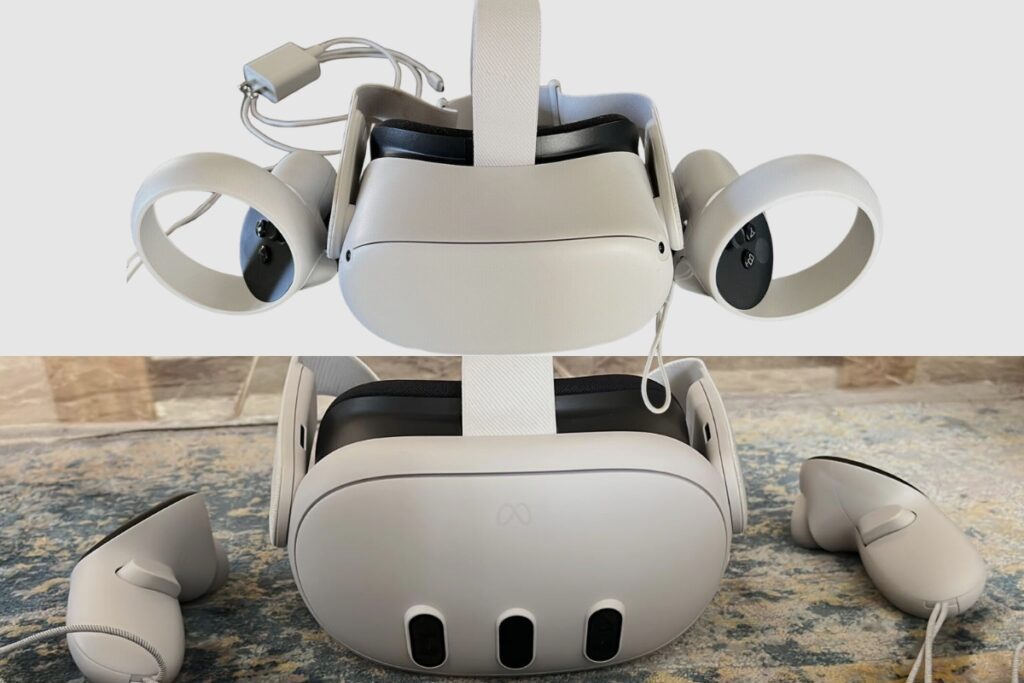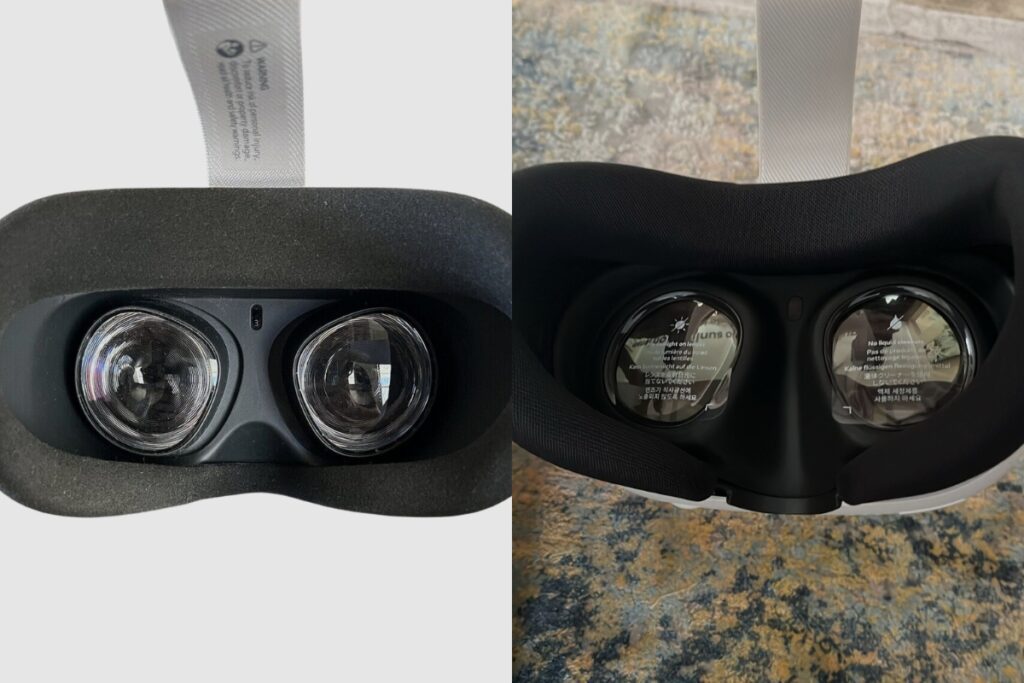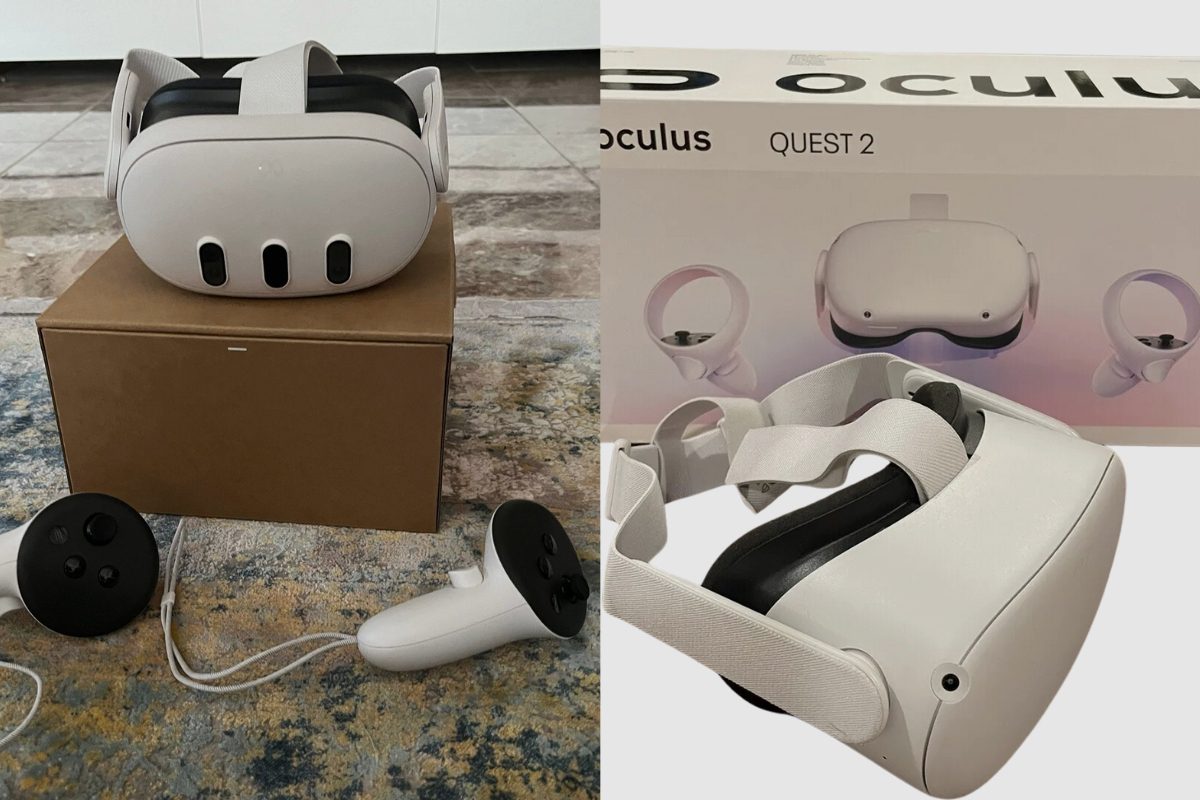The Meta Quest 3 and Meta Quest 2 couldn’t be more different and so similar at the same time. Their differences are as stark as day and night; however, their similarities are also very easy to spot. While it is not hard to tell which one is which (obviously, the Quest 3 has three big optical drives in front and the Quest 2 doesn’t).
The similarities and differences between both devices are very apparent. So, in this article, I thought now would be a good time to show you the difference between the Meta Quest 2 and Meta Quest 3.
Quick Summary:
The Meta Quest 3 and Meta Quest 2 differ in specs, design, display quality, performance, controllers, battery life, storage, pass-through cameras, and price. The Quest 3 offers improvements like higher resolution, faster processor, and colour pass-through cameras compared to the Quest 2.
- Quick Summary:
- What is the Difference Between the Meta Quest 3 and Meta Quest 2?
- Specs
- Design and Build Quality Comparisons
- Display Quality and Size Comparisons
- Performance Comparisons
- Comparing Controllers
- Battery life Comparisons
- Storage Comparisons
- Pass-Through Cameras Comparisons:
- Price Comparisons
- Pros and Cons of the Meta Quest 3
- Pros and Cons of the Meta Quest 2
- Final Thoughts

What is the Difference Between the Meta Quest 3 and Meta Quest 2?
There are a lot of differences between the Quest 3 and Quest 2, from its overall design to its software and build quality. The differences are a lot, so why don’t we start with the specs and work our way down?
Specs
When comparing two devices, the best place to start is with a quick recap of each of their specs to briefly examine how they stack up against each other.
| Category | Meta Quest 3 | Meta Quest 2 |
Chipset | Snapdragon XR2 Gen 2 | Qualcomm Snapdragon XR2 |
| Resolution: | 2,064 x 2,208 pixels per eye | 1832 x 1920 per eye. |
| Storage | 128GB,256GB | 128GB, 256GB |
| RAM | 8GB | 6GB |
| Battery life | 2.2 hours (rated) | 2-3 hours (rated) |
| Size | 7.2 x 6.2 x 3.8 inches | 7.5 x 4 x 5.2 inches |
| Weight | 18.2 ounces | 17.7 ounces |

Design and Build Quality Comparisons
You won’t discover many differences between Quest 3 and Quest 2 at first glance, and that’s intentional, as Meta is a strong proponent of the maxim “If it ain’t broke, don’t fix it.” Meta hasn’t made many improvements to the design of the Meta Quest 3, aside from the extremely evident 3-camera punch out on the face of the Quest 3. But the increased weight of the Quest 3 was one of the main things I noticed. Compared to the Quest 2 and Quest Pro models, the Quest 3 seems noticeably heavier.
Though it weighs slightly more than the Quest 2 (17.7 ounces), the Quest 3 (18.2 ounces) doesn’t feel heavier. A revised headband makes the Quest 3 significantly sleeker, more compact, and slightly more balanced. The Quest 3’s top strap splits into a Y to distribute the headset’s pressure equally across the back of your head, while the other models feature a straightforward three-point design with small plastic handles on the back for an adjustable fit.
Personal Thoughts
While Meta hasn’t made a lot of substantial changes to the design of the Meta Quest 3, Meta has made a lot of quality-of-life improvements to make the Quest 3 an overall better device, and there are a good number of them.
Display Quality and Size Comparisons
With a resolution of 1832 x 1920 per eye, the Quest 2’s display boasts a high pixel density. It can handle a wide range of content, from productivity apps and multiplayer games to 360-degree videos that are roughly 50% sharper than the original Meta Quest. Additionally, its 90 Hz refresh rate reduces eye strain.
However, compared to the Quest 2, the Meta Quest 3’s display has two 2064 x 2208 LCD pancake lens eye displays with a 30% higher pixel density. Players of Quest 3 will have a far better visual experience thanks to this 30% improvement. The best examples of textural elements are virtual browsers, menus, and in-game HUDs.
Additionally, upon launch, it supports a refresh rate of 120Hz, meaning that fast-paced games like “Beat Sabre” would have much higher frame rates. Every game I tried had an incredibly clear picture, thanks in part to the Quest 3’s enhanced resolution, a depth sensor and fish-eye optics.
Personal Thoughts
The Quest 3 increases the resolution to 2,064 by 2,208, adding over a million more pixels than the Quest 2, which projects a 1,920 by 1,800 image into each eye. Consequently, the Quest 3 is much more precise than the Quest 2. Purchasing the Quest 3 makes perfect sense if visual quality is crucial to you.

Performance Comparisons
Regarding performance, Meta states that the Meta Quest 3’s new Qualcomm Snapdragon XR2 Gen 2 CPU can process graphics twice as well as the Quest 2’s. In addition, you receive 8GB of RAM as opposed to the Quest 2’s 6GB.
All of that strength, though, has a slight catch. The majority of launch titles and older games won’t be able to utilise the Quest 3’s more powerful resources until developers issue an optimisation update.
Although the graphics are still not ultra-realistic, they are unquestionably better than those in some of the previous Meta Quest 2 titles. The Quest 2 graphics gave me the impression of being in an outdated arcade game, but the NFL Pro Era app functioned flawlessly.
This is expected given that the Meta Quest 2 is equipped with a Snapdragon XR2 Gen 1—a variant of the Snapdragon 865 created especially for virtual reality and augmented reality. Its new processor provides a noticeable speed increase over its predecessor. It also offers 6GB of RAM and 128GB or 256GB of storage.
Personal Thoughts
The Snapdragon XR2 Gen 1 CPU powers the Quest 2, while the Snapdragon XR2 Gen 2 powers the Quest 3. Both chipsets are built around Qualcomm’s mobile Snapdragon 8 CPU. Qualcomm claims that there is a significant improvement between the XR2 Gen 2 in the Quest 3 and the XR2 Gen 1 in the Quest 2, with the latter having 8 times the AI processing power and 2.5 times the graphics power.

Comparing Controllers
Though it may sound harsh, given how excellent the headset itself is, the new “Touch Plus” controllers are the greatest feature of the Meta Quest 3. The most noticeable modification that Meta has made to these controllers is the elimination of the heavy infrared rings that were included on earlier Quest controllers. Meta made the correct decision in terms of ergonomics with this update.
With the “rings” removed, the revised controllers feel lighter in the hands and appear less top-heavy and unbalanced. They feel nearly flawless at this point. But how has the tracking accuracy changed once the “rings” were removed? In a nutshell, they are no longer necessary.
Meta claims that the new “Touch Plus” controllers for the Quest 3 have more accurate AI hand-tracking than the IR rings that were previously in use. A mixture of infrared LEDs from the visor’s cameras are used by the controls.
On the other hand, the Meta Quest 2 controllers still follow older design patterns carried over from its Oculus days. The configuration remains mostly unchanged: the scoop-shaped controllers are equipped with two shoulder buttons for actions such as firing weapons and grabbing objects, along with two face buttons and clickable analogue sticks on each controller. To prevent them from flying away during a heated lightsaber duel, you also need to fasten them using the wrist straps that are supplied.
The controllers for the Meta Quest 2 are straightforward to use and comfortable to use in a range of games and scenarios. Pistol Whip’s rapid triggers and precise motion detection made it simple for me to take headshots, while Beat Saber’s rhythm action made it easy for me to cut away at colour-coded blocks.
Impressive is the haptic input on the controllers; in Vader Immortal, I could feel the exact buzz of an ignited lightsaber, and in Tetris Effect, a modest pulse matched the in-game music and kept me on course. Coloured blocks during Beat Saber’s rhythmic motion.
Personal Thoughts
I won’t lie, from the moment I picked up the Meta Quest 3 controllers I knew they were the better pair. Finally, ditching the IR rings was a master stroke as it balanced out the controllers and, more importantly, allowed them to utilise AI hand-tracking technology to accurately track and reproduce hands at a greater pace than the older Quest 2 controllers. I think the difference was very clear between both headsets.
Battery life Comparisons
Among all standalone VR headsets, battery life is the lowest feature. The Quest 3 and Quest 2 both run out of juice after less than three hours. It involves using your applications wisely if you want to stay up past two hours. Using them as a standalone requires frequent recharging, but you can put either one into a USB-C port as a tethered headset for power or just to connect to your PC.

Storage Comparisons
With 8GB of RAM, the Meta Quest 3 headset has more RAM than the Quest 2’s (6GB), but less than the Quest Pro’s (12GB). There are also two storage options for the Quest 3: 128GB ($499) and 512GB ($649), which is also the same as the Quest 2, as they made the switch from 64GB to 128GB.
Pass-Through Cameras Comparisons:
Via the outward-facing cameras on both headsets, you can wander outside of your designated play area and see your surroundings. Sharp colour cameras are featured on the Quest 3, whereas blurry black-and-white cameras are found on the Quest 2.
Though they can’t quite replicate what your eyes can see, the Quest 3’s cameras do a respectable job of capturing the scene. Rather than being surrounded by either a fuzzy grayscale or a computer-generated scene, you may comfortably sit on your couch and gaze at a large virtual screen in your living room. The improvement in the augmented reality experience provided by the Quest 3’s colour cameras cannot be overstated.
Price Comparisons
Quest 2 costs $300, and Quest 3 costs $500. The Quest 3 comes with a significant price premium, although not as much as the $1,500 Meta Quest Pro. If cost is your primary issue, you can stop here and choose the less expensive headset. But what do you get for your extra cash?

Pros and Cons of the Meta Quest 3
Pros
- With colour pass-through cameras, you can view your surroundings vividly.
- It produces high-quality images
- Powerful processor
- Pleasant style
Cons
- Short battery life
- Lacks eye-tracking tech
Pros and Cons of the Meta Quest 2
Pros
- There are no cables required.
- A clear display
- Processor with high performance
- precise Motion tracking
- PC tethering via an accessory cable is optional.
Cons
- Short battery life
- Lacks eye-tracking tech
Final Thoughts
In practically every way, the Meta Quest 3 improves on the Meta Quest 2. It boasts a better resolution, a faster processor, and colour pass-through cameras that elevate the VR (and AR) experience. If you can afford it, the Quest 3 VR headset is the one to get.
However, the Quest 2 has not outlived its usefulness. The headgear isn’t as quick as the Quest 3, but it runs all of the software available on the Meta Quest platform without seeming slow. Just keep in mind that AR experiences will either not work with the Quest 2 or will be uncomfortably monochromatic (and VR will not appear as sharp). At $300, the Quest 2 is the best budget-friendly headset for exploring VR without breaking the bank.

